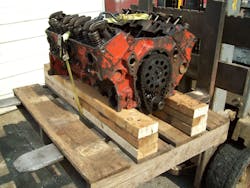As a company who owns and maintains a fleet of road equipment you will eventually have to remove, repair or replace a primary power unit, transmission or other large component and send it off to a repair facility. While processes involving nuts, bolts, crankshafts and valves are familiar to those in the fleet maintenance business, shipping an engine does not likely fall into the expertise of your top mechanic.
Let’s start with the basics: Most large equipment parts weigh more that 150lbs. This means that they are too heavy to ship as a parcel but will likely not occupy an entire truck; hence they will fall in the category of less-than-truck load (LTL). LTL carriers have specific rules about the freight they carry. The nuances of engines, transmissions and mechanical parts require special care to meet those requirements.
You can’t just hand an LTL carrier an engine and send it on its way — the shipment of engines and transmissions requires important preparation and packaging before it’s ready to hit the road. Start by washing up the engine or transmission using your commercial degreaser or a Mean Green style cleaner combined with a power washer or a scrub brush and a hose. It’s important that the engine or its container doesn’t look greasy and oily because a carrier will refuse pickup if the package is leaking oil. The main concern is leakage – make sure to completely drain an engine or transmission of all fluids and oils. Since it’s impossible to get all the oil out of an engine without disassembling it, the secret is that carriers typically allow up to one quart to remain. As long as the dipstick shows empty you will be good to go.
Packaging is also an important (and unique) step to shipping large auto parts. Every engine and transmission is different, and therefore, every packaging solution must be custom tailored for safe and secure shipping. The most popular method of packaging an engine or transmission is on a pallet. Place the engine or transmission in the center of a pallet and block it with 2x4s and screws to make sure it’s well supported on the pallet. It’s best to support the part on its mounting points, such as motor mounts instead of letting it sit on the oil pan. Next, secure it with industrial ratcheting straps, ropes or chains. Now is not the time to be stingy with your ties: the component should not shift or budge from the security of the pallet base—it has to be “one” with the pallet.
Once the engine or transmission is secured to the pallet, it’s time to cover up all your handiwork. LTL carriers will not accept engines and transmissions that are not completely concealed. The caveat to this is that the carrier must have access to the fluid intakes on the component—they will check the dipstick to make sure you were paying attention and drained the fluid. Use some cardboard and/or foam to cover the component, and then shrink-wrap the whole apparatus.
If you choose to ship your engine part in a wooden crate, be sure that it is securely fastened to the base of the crate, preferably with through bolts. The lid of the crate should be easily removable and replaceable, so that the carrier can check the dipsticks.
Now that you have properly prepared your part for shipping, it’s time to book your shipment. One of the easiest ways to arrange for shipment is through an online LTL freight exchange such as www.shipxfreight.com. Start by entering origin and destination address information. Next you must accurately measure the outside dimensions of your package and weigh it to the nearest pound. It’s important to get this right because the carrier will charge you if your freight is heavier or larger than you claim. Once these dimensions are entered, ShipX provides you with quotes from leading LTL providers.
Selecting the right carrier is important. Besides looking at the price to ship your object, also you should consider the transit times and the customer review rating of the carrier by previous shippers. If you are in a hurry to get the engine to its destination, you might choose a different carrier than if you have a tight budget but plenty of time.
When you have selected your carrier, your job is almost done. Enter payment information and create the Bill of Lading (BOL). It’s important to use the BOL ShipX provides and include as much detail as possible on the BOL. This will be attached to the shipment prior to departure. Keep your copies to prevent confusion or disagreement with the carrier over specifics. The ShipX system will automatically dispatch a truck from your carrier to pick up the load, and then keep you posted on its progress all the way to its destination.
With proper care, shipping an engine, a transmission or any other large mechanical part can be quick and easy—so you can move on to more important things. Like maintaining your fleet.
Information provided by: ShipX


